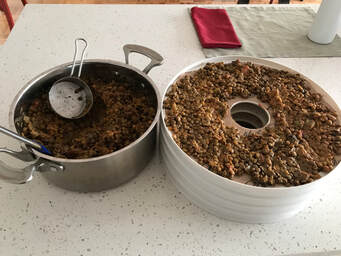Making home-made dehydrated meals takes time. A pot of chili may take a few hours to cook; add to that the 12-24hrs of drying time required to dehydrate fully and it is plain to see that this is a time-consuming option. However, these meals are delicious, healthy, and cost a fraction of store-bought meals. If we have the time, we opt for this method of meal preparation.
Here is basic information regarding dehydration.
Dehydration will not affect elements such as Calories, carbohydrate and proteins values, fiber, or minerals. But it will remove water soluble vitamins such as vitamins B, and C.
For the dehydrated food to be safe from molds and bacteria, it needs to be ninety-five percent dehydrated. Since there is no way of measuring this at home, develop an ‘eye’ to determine when items are fully dried. The dried foods should NOT be sticky or tacky to the touch. They should NOT be soft but SHOULD snap or crunch easily when broken.
Here is basic information regarding dehydration.
Dehydration will not affect elements such as Calories, carbohydrate and proteins values, fiber, or minerals. But it will remove water soluble vitamins such as vitamins B, and C.
For the dehydrated food to be safe from molds and bacteria, it needs to be ninety-five percent dehydrated. Since there is no way of measuring this at home, develop an ‘eye’ to determine when items are fully dried. The dried foods should NOT be sticky or tacky to the touch. They should NOT be soft but SHOULD snap or crunch easily when broken.
Some foods require a bit of preparation prior to the dehydration process. Fruits can be sliced and dipped into diluted lemon juice (ascorbic acid). This reduces the oxidation, or browning, and fends off bacterial growth. Most bacteria thrive around a PH of 7.4 while lemon juice’s PH is between 2-3. This is enough to inhibit the growth of many bacteria harmful to humans.
Vegetables that are normally eaten raw can be dehydrated as is. While vegetables that are typically eaten cooked can be fully cooked, or blanched, prior to the drying process.
Eggs and minced meats can be tough when dried and reconstituted. In his book, Recipes for Adventure, chef Glenn McAllister recommends adding cooked polenta to scrambled eggs and dried breadcrumbs to lean ground meats prior to cooking. The mixture is cooked, dried, then crumbled. The resultant mix reconstitutes well.
Vegetables that are normally eaten raw can be dehydrated as is. While vegetables that are typically eaten cooked can be fully cooked, or blanched, prior to the drying process.
Eggs and minced meats can be tough when dried and reconstituted. In his book, Recipes for Adventure, chef Glenn McAllister recommends adding cooked polenta to scrambled eggs and dried breadcrumbs to lean ground meats prior to cooking. The mixture is cooked, dried, then crumbled. The resultant mix reconstitutes well.
Individual food items can be dried separately and then combined into different recipes. Another way to dry foods consists of preparing thick soups and stews that are then dehydrated. Remember to pay attention to the wet volume of foods, as they reduce significantly once dry. This way, portions sizes will be more accurate.
We use both methods. We dry fruit and beef jerky individually, and we create stews that we dehydrate in bulk. Our favorite recipes can be found in a separate page here.
We use both methods. We dry fruit and beef jerky individually, and we create stews that we dehydrate in bulk. Our favorite recipes can be found in a separate page here.
|
We recommend purchasing a food dehydrator. Using the oven to dry foods is possible but it is slower and uses more energy. The dehydrator maintains the perfect drying temperatures, and the fan aids in the evenness of the drying.
A vacuum sealer is also a great tool. Once foods are dried, portions can be measured out and packaged individually. Vacuum sealing will remove all the air. Packaged in this way, most dehydrated food will last for about a year. Remember to label the bags as most dried foods look about the same. |

